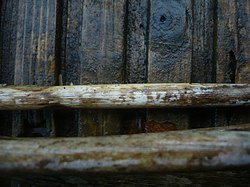| Acanthobasidium | |
|---|---|
 | |
| Acanthobasidium delicatum | |
| Scientific classification | |
| Kingdom: | Fungi |
| Division: | Basidiomycota |
| Class: | Agaricomycetes |
| Order: | Russulales |
| Family: | Stereaceae |
| Genus: | Acanthobasidium Oberw. (1966) |
| Type species | |
| Acanthobasidium delicatum | |
| Species | |
Acanthobasidium is a genus of fungi in the Stereaceae family. The genus, which contains three species found in Europe, [1] was circumscribed by mycologist Franz Oberwinkler in 1966. [2]